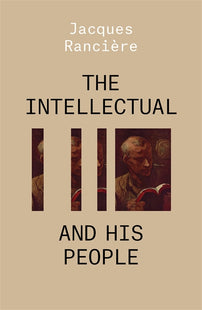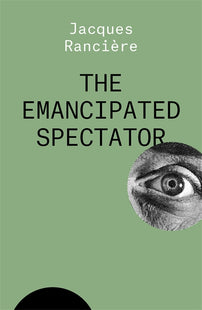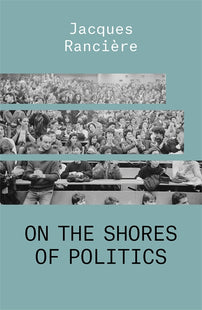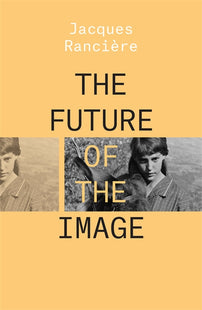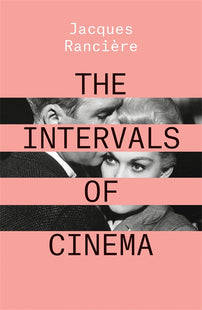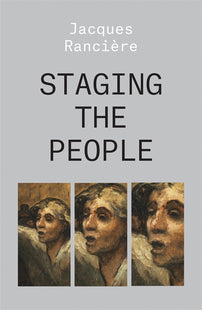The Painter, the People and the Union
In this new edition of a classic, The Intellectual and His People, Jacques Rancière analyzes a question key to struggle: How does the intellectual relate to the masses they theorize about and, ultimately, for?

With inciveness and originality, Rancière rips apart conventions of radicalism through explorations of Foucault and Sartre, the artistic avant-garde and the political and cultural issues of the moment that will allow us to better face our future.
In early 1977 the left press could announce, on its arts pages, some remarkable news: the establishment of a CGT [1] division for visual artists. This event certainly had an exemplary value: the individualist artist finding the path of trade-union organization; the accursed/cherished child of the bourgeoisie joining the workers’ headquarters. What finer example of the rise in consciousness that the crisis of capitalism necessarily produces among people of culture, even when they belong to the most irresolute strata of the irresolute petty bourgeoisie? Of course, this event makes it possible to measure the force of attraction that the union idea exerts today even on activities furthest from the heart of industrial production and the wage-earning condition. But despite all this, the main symbol was rather on the sidelines, in the presence on the committee of this union of one of those ‘provocateurs foreign to the working class’ that the Gaullist government had tried to expel in May 1968, Julio Le Parc. [2] The symbolic presence of a process of unionization that does did not have much to do with any consciousness on the part of separated workers that they needed to unite, and represents far less the beginning than the end of an activist history: that of committed painters in the gauchiste movement, starting from the Vietnam War and the popular workshops of May 1968.
To put images in the service of popular struggle, to turn to its benefit the technique that made them artists dependent on the art market and the generosity of the state, was the mobilizing principle of these activist painters, particularly those connected with the battles of the Maoist movement: the Lens tribunal and the project for an exhibition on the miners, [3] the Renault committee of struggle and the project for an Overney exhibition. [4]
In these battles, however, the painters soon came up against the fact that the people are not easy to serve – or even to meet. Undoubtedly they could have warm contacts with miners’ families or the workers of the struggle committee. But the encounter faltered at the point when the desire to produce images for the people clashed with the image that the working-class activists had of their struggle, and with the political leaders who insisted on their own image of the people. Painter and worker might recognize and thank one another: the activist artist for his experience of proletarian struggle, the proletarian for the artist’s specific skills. But this exchange does not give rise to the possibility of any real discussion on the image of struggle to be produced. The Lip workers [5] reacted only with rejection to images of clock mechanisms that seemed to them foreign to the image and needs of their struggle. And these painters perceived the remarks of workers on the Renault struggle committee as pure censorship:
‘When we go and talk to the workers about painting, we find that they have the same discourse as Druon’ (Matieu). [6]
How then to represent struggles and make this representation itself a struggle? Discussion between the two sides scarcely got going. But this was also because access to the people was guarded by the Maoist leaders – in this case those of the Gauche Prolétarienne – for whom the image of the people was a fundamental political issue, and who saw activist artists first and foremost as illustrators of this image. More precisely, activist political thought assigned the activist painter a double role: that of illustrating his or her image of the people, but also of attesting in a struggle to the specific presence of the ‘fraction of the people’ he or she represented – painters alongside engineers, doctors, etc. Artists had both to represent the image of the activists and to represent themselves. And this double representation doubly blocked the encounter that artists wanted between their production and the popular public. First of all by means of censorship, exercised on the planned Overney exhibition to prevent a petty-bourgeois image of the Maoist worker-activist being presented;[7] but also because the possibility of showing these pictures to the popular public was a question of power that escaped the painters. When the latter were preparing an exhibition on the mines, and went to present it in the mining districts, they hoped at last to have an exchange about their painting with the people whom and for whom they painted. The Communist municipality that had – initially misinformed – lent its Salle des Fêtes for an exhibition of ‘Parisian painters’, became aware that it was dealing with gauchistes and warned the population to avoid this provocation. But the outcome of this missed opportunity was not the same for the painters who packed up the canvases that no miner had seen and for the activists who had sent them to the mining districts. The censorship that meant for the former a complete failure of their desire to connect with the masses, was seen by the latter as an exemplary political demonstration of the oppression that revisionism exercised on freedom of expression. At bottom, there was a solidarity between the two political opponents that worked to the detriment of the activist painters – who alone had the unconditional desire to show the workers what they had done. The Communist managers respected them as painters but rejected them politically. The Maoist leaders rejoiced at the painters’ participation in the struggle but had no real interest in the popular public seeing their work, and were equally happy (perhaps more so) if they could not, so long as this censorship served as a political lesson. On the side of both image production and image presentation, the people were closely guarded. This double barrier returned these painters’ desire to serve back into their own collectivity. But at the same stroke, the impossible encounter between the image of the painter and the image of the people would be reproduced within this collectivity – and with it the power of the activist third party.
Exemplary in this respect was the discussion held in May 1973 for the show ‘À travail égal, salaire égal’, at the Salon de la Jeune Peinture. For this egalitarian project, painters or collectives had to present work in a standard black-and-white format. The desire to struggle against ‘individualist’ or ‘liberal’ artists was also expressed in collective criticism. The management examined each project to decide if it met the terms, or had to be altered to fit the framework of this exhibition on labour. In these debates, however, a constant theme that arose was the divorce between pictorial prac- tice and political intention, often expressed in an appended text. ‘In the majority of cases it’s the text that is political, the canvas has nothing to do with it’ (Matieu).[8] So little, in fact, according to the critics, that it often proposed an ambiguous meaning, or even one opposed to that attributed by the artist. A project on the oppres- sion of the assembly line, for example, provoked the following comment:
Without radical alteration, the mock-up could equally be seen as praising the assembly line. It could just as well have adorned Taylor’s office. There is a balance, a space, a silence, giving the impression that the assembly line is an ideal solution.
Summoned to add to his canvas the missing human element (‘Man is the primary element, the machine the secondary one’), the unhappy painter could only respond with the proposal of adding a hand with a spanner, which still failed to give a very glorious image of workers rebelling against the assembly line . . . Almost all the projects met with the same objection: representing work and people at work was not representing and serving the struggles of the workers. The inability to put this struggle into the image was also expressed in the opposite sense, when the image was devoured by the text that spoke the class struggle. In one project, ‘three-quarters of the work is made up of letters’. The most radical project was characterized by the absence of any image production: this was a project on the work of the painter, reduced to a reproduction of Courbet’s L’Atelier and surrounded by a blank space designed to be filled with the criticism of other canvases. Between an image without class struggle and a class struggle without image – one that was only a class struggle among painters – didn’t the impossibility of a positive politics of the image simply relate to the absence of the painter’s anchorage in the struggles of the moment?
It’s as if the army isn’t occupying Larzac, as if there weren’t Fos-sur-mer, as if there aren’t employers’ militias . . . We have constant discussions, committee meetings or general assemblies, in which everyone talks about the struggles of the proletariat, etc . . .; yesterday again, there were comrades who presented the most gauchiste texts, in which there is ‘class struggle’ on every line, and which are simply based on criticism within our group, looking at their navels . . . and when it is time to make mock-ups there are no struggles at all. There is not one mention in this exhibition of a struggle that has taken place in France this year . . .
Hence the impossibility of resolving the question of the public.
[1] Confédération Générale du Travail, the traditionally Communist- aligned trade-union confederation. [Tr.]
[2] Argentinean kinetic artist (b. 1928), based in Paris and founder of the Groupe de Recherche d’Art Visuelle. [Tr.]
[3] Lens tribunal: ‘popular’ tribunal set up in 1970 and led by the Maoist former miner Jacques Tournel (1927–1998) to try the coal mining company for the accident of Fouquières-lez-Lens in February of that year. Both Serge July and Jean-Paul Sartre were involved. [Tr.]
[4] Pierre Overney (1948–1972): member of the Maoist group Gauche Prolétarienne who was sacked from Renault, and shot dead by a Renault security guard on 25 February 1972 outside the Billancourt factory. His funeral on 4 March was attended by 120,000 people, bringing together left organizations and figures such as Michel Foucault and Sartre. [Tr.]
[5] Lip: clock and watch factory at Palente near Besançon which was the site of an important series of struggles in 1973–6 when, faced with closure, the workers took over the factory and started to run it as a self-managed cooperative. [Tr.]
[6] The quote is from an interview with M. Matieu (September 1977). [Maurice Druon (1918–2009): novelist who won the Goncourt prize in 1948 for his book Les Grandes familles, and Gaullist Minister for Culture under the Pompidou government (1973–4). Tr.]
[7] ‘The best example was Ipoustéguy’s statue for the Overney exhibi- tion. First of all, it was not lifelike. What they wanted was the kind of bust you put up in a public square. Second, the discussion by the officials: was it Overney who should carry the émigré or the other way round? Third: why was the émigré dead? Fourth: the erect penis was unacceptable – a petty-bourgeois idea, you don’t get an erection when you’re doing politics’ (Matieu, ibid.).
[8] The following quotations are taken from the account of this gathering kindly provided by Claude Lazare. The various interventions had first of all to be reworked for publication. And as those involved, frightened by the dogmatism of their contributions, finally refused to repeat them, we have preferred here to leave them anonymous.
[book-strip index="1" style="display"]